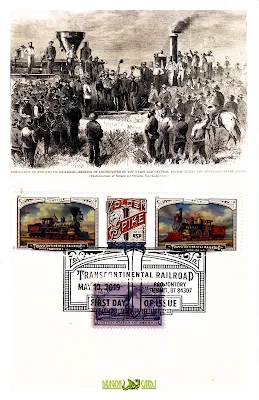USPS on 10 May 2019 issued three Forever stamps commemorating the 150th anniversary of the Transcontinental Railroad. The se-tenant featured the Central Pacific Railroad's Jupiter on the left, Union Pacific Railroad's No. 119 on the right, and "Golden Spike" in the centre. Cancellation postmark for first day cover originated from Promontory Summit, Utah. Banknote Corporation of America used an offset printing method. A total of 50,400,000 self-adhesive stamps were printed.
America's First Transcontinental Railroad was the famous pathway connecting the East and West Coasts of the United States. It took six years to complete (1863-1869) and shortened cross-country travel from several months to just a few days.
The Jupiter, also known as Central Pacific Railroad #60, made its first run on March 20, 1869. Less than two months later, the Jupiter made history as one of the two locomotives that met at Promontory Summit, Utah to mark the completion of America’s First Transcontinental Railroad.
Jupiter was a popular name for locomotives in the 1800s. Named after the “King of Gods” or the “God of the Sky,” Jupiter was a name that inspired wonder and excitement. Walter McQueen designed his Jupiter, a 4-4-0 steam locomotive, and it was built in 1868 at the Schenectady Locomotive Works. Once complete, it was disassembled and transported by ship to the Central Pacific headquarters in San Francisco. Jupiter was reassembled and had its first run on March 20, 1869. It was run up and down a test track on Front Street and reportedly ran perfectly. Jupiter was then sent to Nevada to haul passenger trains. It would soon become a part of history.
The Jupiter, also known as Central Pacific Railroad #60, made its first run on March 20, 1869. Less than two months later, the Jupiter made history as one of the two locomotives that met at Promontory Summit, Utah to mark the completion of America’s First Transcontinental Railroad.
Jupiter was a popular name for locomotives in the 1800s. Named after the “King of Gods” or the “God of the Sky,” Jupiter was a name that inspired wonder and excitement. Walter McQueen designed his Jupiter, a 4-4-0 steam locomotive, and it was built in 1868 at the Schenectady Locomotive Works. Once complete, it was disassembled and transported by ship to the Central Pacific headquarters in San Francisco. Jupiter was reassembled and had its first run on March 20, 1869. It was run up and down a test track on Front Street and reportedly ran perfectly. Jupiter was then sent to Nevada to haul passenger trains. It would soon become a part of history.

No comments:
Post a Comment